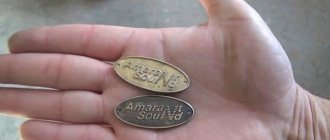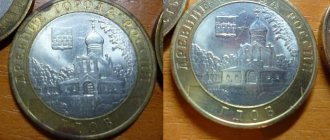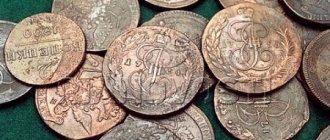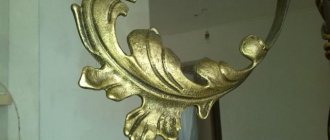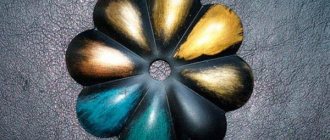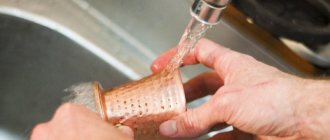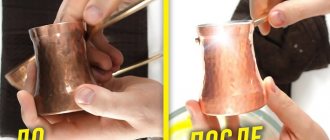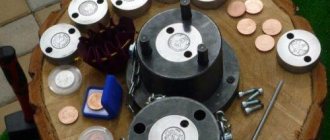The fabulous charm of the ancient cities of Europe is given not only by the exquisite ancient architecture, but also by the tops of the towers of an attractive green-blue color. This natural color of bronze is given by patina - a coating formed on copper, its alloys or other metals subject to oxidation. The bronze sheets that cover the domes and tops of the towers are initially dark brown in color. But after a few years, emerald islands begin to appear in the chocolate sea, which, growing, gradually hide the former color under a bright film.
The word “patina” comes to us from the Italian language, which inherited it from Latin, where patina is a small piece of utensils made of bronze. Oxidation processes create a patina consisting of many layers, but in conversations the word “patina” most often means only the top of them.
Not only dishes, but also coins were made from bronze. Therefore, people quickly became familiar with the patina on money. Patina is a natural and irreversible process. It can only be slowed down by preserving the item in an environment where oxidation will have an extremely gentle effect on it. That is why numismatists recommend storing coins in sealed capsules.
Types of patina
For collectors of modern anniversary items, patina is pure punishment. I almost forgot about the new bimetal or galvanized steel ten, and the stamped shine had already disappeared. Imperceptibly, the coin darkened and became dull. But patina sometimes transforms ancient coins for the better. Numismatists divide patina into several characteristic types:
- Natural – a layer of oxides on the surface of the coin;
- “Cabinet” – a smooth patina obtained by long-term storage of the coin in a wooden box or cabinet (a specialized cabinet for storing numismatic items);
- Rainbow – multi-colored patina;
- Bullet - a subtype of rainbow patina, when the colors change from light in the center to dark closer to the edge;
- Iridescent - a subtype of iridescent patina, when colors change depending on the viewing angle;
- Sandy - an even beige-yellow coating on coins that have been in the sand for a long time and exposed to silicic acid;
- Artificial - an induced layer to give the coin beauty and hide defects.
Above is a pair of royal coins that have begun to develop a natural patina. The first to change their shine to a matte color are the relief elements, which is especially noticeable on a penny. And, conversely, if the coin field is covered with patina, and the protruding elements look light (not patinated), then this is considered a defect called “cabinet wear.” A beautiful natural patina is highly prized and increases the value of the coin.
Artificial patina will be revealed by a thorough examination of the suspicious specimen. For example, it is clear that the patina lay over scratches and damage to the coin field or, on the contrary, did not cover its recesses. Unusual colors and shades of patina, as well as sharp transitions from color to color, should also raise suspicions. The yellow-brown smoky tint indicates that the patina was caused by tobacco smoke.
Is a patina-covered coin an advantage or a disadvantage?
The fabulous charm of the ancient cities of Europe is given not only by the exquisite ancient architecture, but also by the tops of the towers of an attractive green-blue color.
This natural color of bronze is given by patina - a coating formed on copper, its alloys or other metals subject to oxidation. The bronze sheets that cover the domes and tops of the towers are initially dark brown in color.
But after a few years, emerald islands begin to appear in the chocolate sea, which, growing, gradually hide the former color under a bright film.
The word “patina” comes to us from the Italian language, which inherited it from Latin, where patina is a small piece of utensils made of bronze. Oxidation processes create a patina consisting of many layers, but in conversations the word “patina” most often means only the top of them.
Not only dishes, but also coins were made from bronze. Therefore, people quickly became familiar with the patina on money. Patina is a natural and irreversible process. It can only be slowed down by preserving the item in an environment where oxidation will have an extremely gentle effect on it. That is why numismatists recommend storing coins in sealed capsules.
Types of patina
For collectors of modern anniversary items, patina is pure punishment. I almost forgot about the new bimetal or galvanized steel ten, and the stamped shine had already disappeared. Imperceptibly, the coin darkened and became dull. But patina sometimes transforms ancient coins for the better. Numismatists divide patina into several characteristic types:
- Natural – a layer of oxides on the surface of the coin;
- “Cabinet” – a smooth patina obtained by long-term storage of the coin in a wooden box or cabinet (a specialized cabinet for storing numismatic items);
- Rainbow – multi-colored patina;
- Bullet - a subtype of rainbow patina, when the colors change from light in the center to dark closer to the edge;
- Iridescent - a subtype of iridescent patina, when colors change depending on the viewing angle;
- Sandy - an even beige-yellow coating on coins that have been in the sand for a long time and exposed to silicic acid;
- Artificial - an induced layer to give the coin beauty and hide defects.
Above is a pair of royal coins that have begun to develop a natural patina. The first to change their shine to a matte color are the relief elements, which is especially noticeable on a penny.
And, conversely, if the coin field is covered with patina, and the protruding elements look light (not patinated), then this is considered a defect called “cabinet wear.”
A beautiful natural patina is highly prized and increases the value of the coin.
Artificial patina will be revealed by a thorough examination of the suspicious specimen. For example, it is clear that the patina lay over scratches and damage to the coin field or, on the contrary, did not cover its recesses. Unusual colors and shades of patina, as well as sharp transitions from color to color, should also raise suspicions. The yellow-brown smoky tint indicates that the patina was caused by tobacco smoke.
Patina on copper coins
Most often, collectors are faced with the destructive effect of patina on copper coins. Its color depends on the storage conditions of the specimen.
The characteristic green color is given to the coin by sulfates and sulfides formed on the surface of the metal. Coins extracted from the ground have a coal-black tint - this is copper oxide that has affected its deep layers.
Bright green-blue islands are also not pleasing to experienced collectors, since they can move from affected coins to others.
Collectors love a smooth, monochromatic patina that is pleasing to the eye, where minor defects in the coin field cannot spoil the overall impression. It is this kind of patina that is often called “cabinet” or “noble”. Such coins are valued much higher than motley or spotted ones.
The patina on copper coins is important when grading. Together with the assessment of the degree of preservation, the expert often confirms one or another shade of copper: “BN” (Brown), “RD” (Red) and “RB” (Red Brown). This parameter, fixed on the weak, can also affect the price of the coin.
Patina on coins made of copper alloys
Traditional tin bronze is close to copper in color.
And since copper predominates in the alloy, the patina on bronze, despite the higher strength of the alloy, is similar to that formed on pure metal.
As an example, we took a bronze coin from the late Roman Empire, on which bright inclusions of green-blue color are clearly visible. This is the formation of copper chloride (exposure to hydrochloric acid on the metal).
Soviet everyday coins of the older group of denominations (from 10 kopecks and above) were made from copper-nickel alloys cupronickel (until 1957 inclusive) and nickel silver (since 1961). Circular copies simply faded, becoming gray.
If the coins fell into an aggressive environment (moisture or soil), the surface transformation process went faster.
Copper plating of the coins occurred (copper protruding on the surface of the alloy), and the patina in appearance could resemble that formed on pure copper.
The junior group of denominations, from a kopeck to a nickel, was first minted from golden aluminum bronze and then from brass. Brass very quickly lost its original luster, darkening and tarnishing. The 1973 5 kopecks shown above show both an example that retains its stamp shine and a coin that has lost it.
From 2006 to 2014, Russian 10 and 50 kopeck coins were made from steel clad with tompak alloy (a type of brass). The coin shown above, although very dark, has acquired an unusual iridescent patina.
Patina on silver coins
Iridescent patina on silver coins can be found much more often than on copper.
Previously, such a variety of colors could greatly increase the price, since such a specimen looked very advantageous against the background of ordinary coins, even if they had a stamp shine.
Nowadays, there are many ways to create a rainbow patina. However, the artificial patina stands out with bright, unnatural colors that scare off experienced collectors and attract only beginners.
Let's look at the classic bullet patina. Its name comes from the similarity of the coin, which has such a patina, to one of the types of bullet targets. The coin field of the Soviet silver fifty-kopeck piece shown above contains smooth transitions of patina from light to dark tones, like on a target.
Tsarist and early Soviet bilon coins are 500-carat silver. The alloying additive to the precious metal is copper. Due to its presence, a thin layer of silver sulfide may form on the coin - a malachite-colored patina. It reduces, rather than increases, the price of the coin, so they are trying to remove it.
Patina on gold coins
Pure gold is a metal that is practically not subject to oxidation. This section appeared only because pure gold was not used for everyday coins of past centuries because of its softness.
To give gold strength, it was alloyed with a small amount of other metals (usually silver and copper, less often nickel or molybdenum). The five-ruble note of Nicholas II, taken as an example, is 900-carat gold. The alloying additive to it is still the same copper.
Under certain conditions, copper can appear on the surface, and even such a small amount will cause the coin to darken in fragments (as in the illustration above).
More often on gold you can find rust stains, caused by the same oxidation process. During minting, chipped microparticles of the stamp may become pressed into the surface of the gold, and after a few years the coin will become unsightly.
In Russian numismatics, the most famous are the rusty gold “Victory Bearers”. After the scandal with SPMD gold coins, Russian minting technology was improved, and such defects began to occur much less frequently.
Both rust and patina always reduce the value of gold coins.
Patina on aluminum coins
Aluminum was often used in coinage in the 20th century. Basically, small denominations were made from it (for example, Hungarian fillers). In the GDR, the entire line of coins, with the exception of the heavy brass 20 pfennig used in the machines, was aluminum.
The oxidation process quickly deprives the aluminum coin of its stamp shine. It becomes dull and inconspicuous, acquiring a matte gray coating.
And if the protruding parts of the relief are still mechanically cleaned during circulation, then the coin field very soon begins to look dirty.
Patina on zinc coins
Zinc patinated coins have the most deplorable appearance. Shown above is a selection of small denominations from Denmark, the Netherlands and Luxembourg from the First and Second World Wars.
In difficult times, metal becomes a strategic raw material, so coins have to be made from the cheapest material. Patina causes zinc coins to darken to such an extent that it is sometimes difficult to make out the designs and inscriptions on them.
It is not surprising that after economic recovery, all these countries abandoned zinc coins, choosing other metals and alloys.
Do I need to remove the patina?
This question is often asked by beginners. There is no clear answer to this. As we have already found out, a beautiful, uniform patina gives antique coins a noble appearance, emphasizing their age and authenticity. The same applies to the iridescent patina, which does not hurt the eyes.
But the black and purple streaks on silver coins (they are also called “horn silver”) greatly spoil the impression. The most difficult situation is with copper. If the patina goes deep, then during the cleaning process the coin risks turning into a thin circle or even falling apart.
But even removing the surface layer often changes the specimen beyond recognition. Patina is part of the coin. Removing it leads to “blurring” of the relief. The field, which previously looked smooth, turns into a collection of holes and ruts. Cleaning copper will never return it to its original appearance, which is what many people hope for when undertaking this process.
Experienced collectors recommend removing patina only in cases where it is guaranteed to improve the appearance of the coin.
Patina is not acceptable on Proof quality collectible coins. However, under incorrect storage conditions (without a capsule or in a damaged seal), both silver and copper-nickel gradually become covered with a whitish patina.
Sometimes the patina can even change the color of the coin, turning it brown, yellow or beige.
Cleaning “Proof” coins from patina is allowed only with the help of a specialized liquid without mechanical impact, otherwise the mirror field will be irrevocably damaged by micro-scratches.
Patination of coins
Collectors who have started cleaning copper coins find that after the patina is removed, the copper acquires an unpleasant reddish-scarlet tint. To give the coin a decent appearance, they resort to artificial patination.
Conservative methods involve keeping the coin in oak boards, in sunlight or in the vicinity of sulfur, for example, in a jar with a scattering of matches. But craftsmen also know how to quickly create a patina using ammonia, ammonia, manganese and copper sulfate.
The use of sulfur ointment has already become classic for copper coins. Coins are also burned and then covered with a layer of baby cream, but most collectors consider this method barbaric.
Manufacturers of numismatics products, of course, have not left this niche empty, offering liquids for creating patina on various metals.
Each collector makes his own choice of which coins to choose for his exhibition: exclusively in stamped shine, cleared of patina or, conversely, only with its presence. And yet, if you come across a specimen with a beautiful and even patina, do not try to immediately remove it. Perhaps it is waiting for its connoisseur, who will consider the coin with it an amazing work of numismatic art.
Patina on copper coins
Most often, collectors are faced with the destructive effect of patina on copper coins. Its color depends on the storage conditions of the specimen. The characteristic green color is given to the coin by sulfates and sulfides formed on the surface of the metal. Coins extracted from the ground have a coal-black tint - this is copper oxide that has affected its deep layers. Bright green-blue islands are also not pleasing to experienced collectors, since they can move from affected coins to others.
Collectors love a smooth, monochromatic patina that is pleasing to the eye, where minor defects in the coin field cannot spoil the overall impression. It is this kind of patina that is often called “cabinet” or “noble”. Such coins are valued much higher than motley or spotted ones.
The patina on copper coins is important when grading. Together with the assessment of the degree of preservation, the expert often confirms one or another shade of copper: “BN” (Brown), “RD” (Red) and “RB” (Red Brown). This parameter, fixed on the weak, can also affect the price of the coin.
Patination of copper coins with ammonia vapor
In order to apply patina to a coin using ammonia, place the coin in a closed container with ammonia vapor for 10-30 minutes, but do not allow the coin to come into contact with the liquid. From a technical point of view, everything is simple, but when it comes to implementation, some difficulties may arise.
While preparing materials for this article, 2 coins were hopelessly lost. To prevent this from happening, follow these simple recommendations:
- Since ammonia has a strong odor, patination should be done in a closed jar or container.
- The coin must either be hung, secured by the edge, or placed on any object inside the container, but not just placed, but on a cotton pad, this will allow the coin to become covered with patina evenly on both sides.
- You need to pour a little ammonia (5-10 grams) into the bottom of the container; it is best to do this at the very end after the rest of the preparations and immediately close the lid.
- Under no circumstances should you heat a closed container; this will cause condensation to form on the coin and cause a very uneven patina.
Vapors from ammonia literally cover the coin in just a few minutes with an even layer of patina of a pleasant brown color. The coin stops shining and looks very attractive. If the coin is left for several hours, the patina does not become more saturated, but pockets of corrosion begin to appear.
Patina on coins made of copper alloys
Traditional tin bronze is close to copper in color. And since copper predominates in the alloy, the patina on bronze, despite the higher strength of the alloy, is similar to that formed on pure metal. As an example, we took a bronze coin from the late Roman Empire, on which bright inclusions of green-blue color are clearly visible. This is the formation of copper chloride (exposure to hydrochloric acid on the metal).
Soviet everyday coins of the older group of denominations (from 10 kopecks and above) were made from copper-nickel alloys cupronickel (until 1957 inclusive) and nickel silver (since 1961). Circular copies simply faded, becoming gray. If the coins fell into an aggressive environment (moisture or soil), the surface transformation process went faster. Copper plating of the coins occurred (copper protruding on the surface of the alloy), and the patina in appearance could resemble that formed on pure copper.
The junior group of denominations, from a kopeck to a nickel, was first minted from golden aluminum bronze and then from brass. Brass very quickly lost its original luster, darkening and tarnishing. The 1973 5 kopecks shown above show both an example that retains its stamp shine and a coin that has lost it.
From 2006 to 2014, Russian 10 and 50 kopeck coins were made from steel clad with tompak alloy (a type of brass). The coin shown above, although very dark, has acquired an unusual iridescent patina.
What is patination and indications for the procedure
The word "patina" is an Italian term. They first learned about it after a chemical experiment was carried out, the reaction of which was the transformation of the surface of the coin. On a silver or copper alloy, a dark coating looks beautiful, but on aluminum it is a cloudy film, which is why such items lose value.
An important condition for patina is complete coverage of the metal, because... individual spots will not add charm to the coin. Therefore, the uneven coating is removed and applied artificially. But, if the oxide film has penetrated deep into the alloy, it is not recommended to touch it. After cleaning, such products will turn into thin plates with shapeless potholes instead of a pattern.
Patination of coins is carried out for several reasons:
- The specimen was purchased or found in poor condition, with traces of corrosion and in need of cleaning. The appearance of excavated cash samples largely depends on the area in which it was found and the quality of the soil;
- increase in cost. Ancient coins with a noble brown coating are much more valuable than coins with green spots on the surface;
- ignorance of the true value of a coin with natural traces of oxidation and the desire to make it shine leads to the loss of the product’s significance. Most often, the patina is worn off or the coin is thrown into acid, after which its color turns yellow-orange.
Patination of coins increases the value. Patination is carried out through a chemical reaction, during which a film or coating is formed. Many years of practice have shown what methods exist for applying patina and how to perform the procedure at home. In the process, you need to maintain the proportions of the substances, otherwise you may lose your rare coin forever.
Patina on silver coins
Iridescent patina on silver coins can be found much more often than on copper. Previously, such a variety of colors could greatly increase the price, since such a specimen looked very advantageous against the background of ordinary coins, even if they had a stamp shine. Nowadays, there are many ways to create a rainbow patina. However, the artificial patina stands out with bright, unnatural colors that scare off experienced collectors and attract only beginners.
Let's look at the classic bullet patina. Its name comes from the similarity of the coin, which has such a patina, to one of the types of bullet targets. The coin field of the Soviet silver fifty-kopeck piece shown above contains smooth transitions of patina from light to dark tones, like on a target.
Tsarist and early Soviet bilon coins are 500-carat silver. The alloying additive to the precious metal is copper. Due to its presence, a thin layer of silver sulfide may form on the coin - a malachite-colored patina. It reduces, rather than increases, the price of the coin, so they are trying to remove it.
Patina process
Undoubtedly, the presence of the “native” patina reliably protects the coin from damage. Ideally, it is better not to touch it at all. However, sometimes the removal of collectible assets is a necessary measure for the following reasons:
- due to the onset of corrosion;
- great pollution;
- strong unevenness of the patination layer.
In such cases, you have to resort to independent patination. In this regard, a reasonable question arises: how to apply artificial patina to a copper coin? The essence of this process is the effect of chemicals and compounds on copper.
The following methods are usually used for patination:
- dip coins into the patination solution;
- apply the solution to the surface with a brush;
- place a banknote in a vapor-gas environment.
The quality of the artificial oxide-carbonate film depends on the method of its preparation and on how well the base is prepared for it.
Preparing a coin for patina involves cleaning its surface from fat and oxides. It is easier to do this with a cotton pad soaked in white spirit or gasoline. These solvents will help clean it from greasy traces that impede the reaction of the patination solution with copper. From this point on, be sure to wear gloves, since the patina lies unevenly on fingerprints left behind.
Patina on gold coins
Pure gold is a metal that is practically not subject to oxidation. This section appeared only because pure gold was not used for everyday coins of past centuries because of its softness. To give gold strength, it was alloyed with a small amount of other metals (usually silver and copper, less often nickel or molybdenum). The five-ruble note of Nicholas II, taken as an example, is 900-carat gold. The alloying additive to it is still the same copper. Under certain conditions, copper can appear on the surface, and even such a small amount will cause the coin to darken in fragments (as in the illustration above).
More often on gold you can find rust stains, caused by the same oxidation process. During minting, chipped microparticles of the stamp may become pressed into the surface of the gold, and after a few years the coin will become unsightly. In Russian numismatics, the most famous are the rusty gold “Victory Bearers”. After the scandal with SPMD gold coins, Russian minting technology was improved, and such defects began to occur much less frequently. Both rust and patina always reduce the value of gold coins.
What is patina?
The word “patina” is of Italian origin, in which it has a general meaning: the formation of plaque, an oxide film on any surface of any material under the influence of environmental factors. It can appear on anything, even on a stone. In essence, this is the same as rust, which iron is susceptible to; the only difference is in the chemical structure, which is determined by the chemical composition of the object itself (in this case, the metal). If rust appears on iron, then patina forms on copper, silver and other non-ferrous metals.
Patina on aluminum coins
Aluminum was often used in coinage in the 20th century. Basically, small denominations were made from it (for example, Hungarian fillers). In the GDR, the entire line of coins, with the exception of the heavy brass 20 pfennig used in the machines, was aluminum. The oxidation process quickly deprives the aluminum coin of its stamp shine. It becomes dull and inconspicuous, acquiring a matte gray coating. And if the protruding parts of the relief are still mechanically cleaned during circulation, then the coin field very soon begins to look dirty.
Patina on zinc coins
Zinc patinated coins have the most deplorable appearance. Shown above is a selection of small denominations from Denmark, the Netherlands and Luxembourg from the First and Second World Wars. In difficult times, metal becomes a strategic raw material, so coins have to be made from the cheapest material. Patina causes zinc coins to darken to such an extent that it is sometimes difficult to make out the designs and inscriptions on them. It is not surprising that after economic recovery, all these countries abandoned zinc coins, choosing other metals and alloys.
Do I need to remove the patina?
This question is often asked by beginners. There is no clear answer to this. As we have already found out, a beautiful, uniform patina gives antique coins a noble appearance, emphasizing their age and authenticity. The same applies to the iridescent patina, which does not hurt the eyes. But the black and purple sagging on silver coins (they are also called “horn silver”) greatly spoils the impression. The most difficult situation is with copper. If the patina goes deep, then during the cleaning process the coin risks turning into a thin circle or even falling apart. But even removing the surface layer often changes the specimen beyond recognition. Patina is part of the coin. Removing it leads to “blurring” of the relief. The field, which previously looked smooth, turns into a collection of holes and ruts. Cleaning copper will never return it to its original appearance, which is what many people hope for when undertaking this process. Experienced collectors recommend removing patina only in cases where it is guaranteed to improve the appearance of the coin.
Patina is not acceptable on Proof quality collectible coins. However, under incorrect storage conditions (without a capsule or in a damaged seal), both silver and copper-nickel gradually become covered with a whitish patina. Sometimes the patina can even change the color of the coin, turning it brown, yellow or beige. Cleaning “Proof” coins from patina is allowed only with the help of a specialized liquid without mechanical impact, otherwise the mirror field will be irrevocably damaged by micro-scratches.
Artificial patina
The high value of ancient coins often serves as a reason for artificially inducing signs of age. This is not always done for the purpose of unjust enrichment. For example, artificial aging is used when creating official copies or after cleaning, which results in an unnatural color for the metal or a shine inappropriate for the age of the coin. In addition, patina is applied to visually hide some physical defects as a result of regular use or improper storage. In any case, artificial “old age” with a certain skill can be easily distinguished from natural one, no matter how beautiful the result looks. There are several ways to obtain it.
Touch up
On the scale of professionalism in creating artificial patina, this method is at the lowest level and is applicable only for the mass production of cheap copies. The first obvious sign of a fake is shine, which should not be present in the genuine case, a thick layer of plaque and its sharp drop in places where the transition to the center should be very smooth. However, it is possible to deceive completely ignorant people with such fakes.
Burning
To give the coin disc an old look, it is heated over an open fire of any type - a gas burner, a blowtorch, a fire, etc. Another short-sighted technique, since the difference is too obvious.
Chemical methods
They can be different, but they come down to simulating conditions that provoke an accelerated aging process. The inventions of entertainers are endless; here are just a few examples:
- A solution of copper sulfate and potassium permanganate based on distilled or simply boiled water, heated below the boiling point. The coin is lowered into it for a short time (a couple of minutes).
- Rubbing with sulfuric ointment followed by rinsing in a solution of ordinary laundry soap.
- Immersion in any sulfuric solution or in sulfuric acid itself. Even ordinary match sulfur is used. The impact is very strong and fast. But the result is easily recognizable.
"Folk art"
The same can be said about it as about chemical experiments, with the difference that natural aggressive environments are used without the use of active substances. These are all kinds of combinations of temperature influences, humid air, water and even food (an example is baking a coin in a potato). Sometimes it is possible to obtain good results, which, however, are clearly distinguishable from the originals by specialists. But without the proper skill, most often the result is a hopelessly damaged coin.
Patination of coins
Collectors who have started cleaning copper coins find that after removing the patina, the copper acquires an unpleasant reddish-scarlet tint. To give the coin a decent appearance, they resort to artificial patination. Conservative methods involve keeping the coin in oak boards, in sunlight or in the vicinity of sulfur, for example, in a jar with a scattering of matches. But craftsmen also know how to quickly create a patina using ammonia, ammonia, manganese and copper sulfate. The use of sulfur ointment has already become classic for copper coins. Coins are also burned and then covered with a layer of baby cream, but most collectors consider this method barbaric. Manufacturers of numismatics products, of course, have not left this niche empty, offering liquids for creating patina on various metals.
Each collector makes his own choice of which coins to choose for his exhibition: exclusively in stamped shine, cleared of patina or, conversely, only with its presence. And yet, if you come across a specimen with a beautiful and even patina, do not try to immediately remove it. Perhaps it is waiting for its connoisseur, who will consider the coin with it an amazing work of numismatic art.
Patination of silver coins with sulfur ointment
Silver coins do not need as much patina as copper coins, but silver coins often sparkle white after cleaning and require a patina to achieve an older appearance.
To apply patina to a silver coin with sulfur ointment, almost the same operations are carried out as on a copper coin, but there are differences. First, the coin should be cleaned in ammonia or citric acid so that the surface is clean and there are no uneven areas. Next, sulfur ointment is applied to the coin, applied in an even, thick layer. Since silver is much less chemically active than copper, patina forms much more slowly. To speed up the application of patina, the coin must be heated; at home, the best way to do this is to place the coin on a cotton pad or soft cotton cloth and heat it with a hairdryer. In 1-2 minutes the silver coin becomes completely dark. Afterwards, the coin must be washed with soap to remove any remaining ointment.
After applying the patina, the coin was rubbed with felt so that the patina on the protruding parts of the coin was a little erased and the relief was more clearly visible. For this coin, such an operation gives a more advantageous appearance, but for heavily worn coins it allows you to raise the relief and sometimes distinguish details that were not noticeable before.
